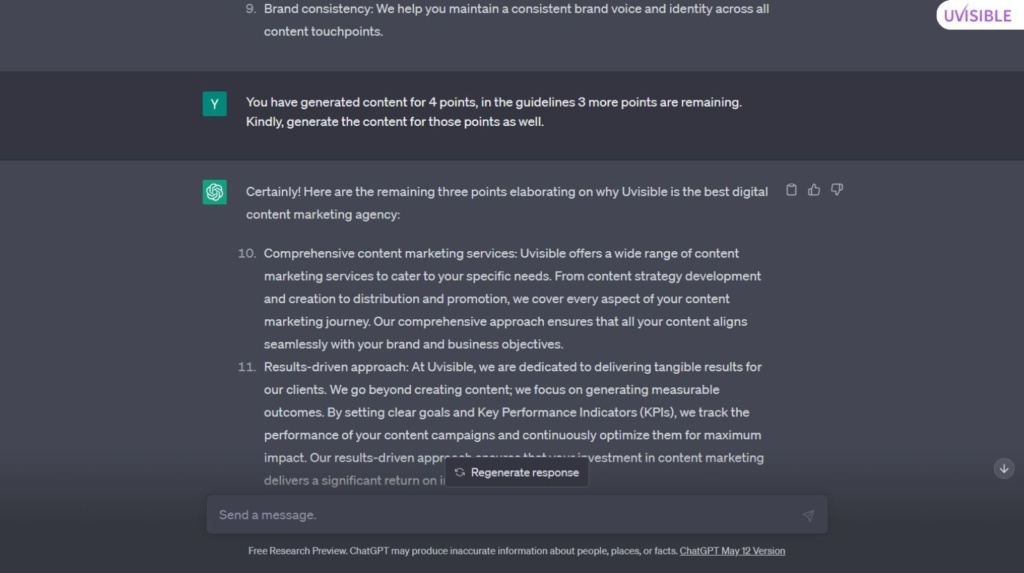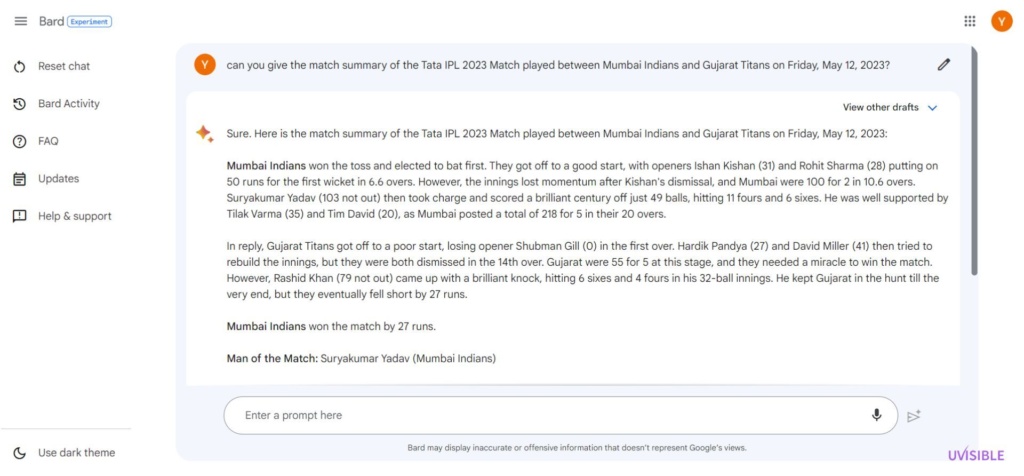Have you heard about the most recent competition between IT behemoths?
OpenAI’s ChatGPT vs Google’s Bard are two AI-powered chatbots changing how businesses communicate.
But which is superior?
In this detailed comparison, we’ll look at ChatGPT (free version) and Bard AI, comparing their features, capabilities, and possible applications.
Introduction
Chatbots have grown in popularity in recent years, offering businesses a more efficient method to connect with consumers and staff.
Rule-driven chatbots are built to do certain tasks, whereas generative AI generates content in response to a user query. Launched in November 2022, OpenAI’s ChatGPT immediately became an online sensation, delivering AI-generated material for a variety of uses. However, with rising consumer expectations, AI chatbot automation technology is more important than ever.
Alphabet, Google’s parent company, has unveiled Bard, a conversational AI chatbot in response to ChatGPT.
Now the issue is, ChatGPT vs Google Bard which is better?
We’ll compare ChatGPT vs Bard AI and look at the major distinctions between the two AI solutions. The rivalry is heating up, with Microsoft now teaming with OpenAI to improve AI capabilities.
By the end of this article, you’ll have a solid grasp of the advantages and disadvantages of ChatGPT and Bard, as well as whether one may be more suited to your company’s needs.
Let’s dig in and learn about AI chatbots!
Background: ChatGPT vs Google Bard A Comparison of the Technical Differences

ChatGPT and Google Bard are two AI chatbots making waves in the tech world.
- ChatGPT
ChatGPT, created by OpenAI, is a natural language processing tool that allows for human-like conversations and can assist with tasks such as composing emails, essays, and code.
The language model was fine-tuned using supervised and reinforcement learning, with the unique addition of Reinforcement Learning from Human Feedback (RLHF) to train the AI through human conversations.
- Google Bard
Google Bard, on the other hand, is also an AI chatbot powered by a language model that uses Pathways Language Model 2 (PaLM 2) to power its more advanced features such as coding and multimodal search, which was recently announced at Google I/O 2023 developer conference.
Initially, it used Language Model for Dialogue Applications (LaMDA) for its training to become conversational.
Google Bard is designed to be conversational and uses a blend of formal and informal tones to respond to user queries or requests, just like any other chatbot AIs.
- Google Bard Recent Updates announced at Google I/O 2023
Google Bard was first released in the United States and the United Kingdom, but it is currently accessible in over 180 nations and territories, with plans to add 40 languages soon.
Among the new features and enhancements to Bard are:
- Making Interactions with Bard More Visual: Users may now include photos in their prompts, and Bard can react with rich visuals and words to help the user comprehend the inquiry.
- Introducing Code Enhancements and Export Capabilities: Source citations, a dark style, and the ability to export and run code with Replit are now available to developers. There are also two new Export Actions to directly import Bard’s replies into Gmail and Docs.
- Connecting Bard with the Services You Love: Bard is now linked with Google apps and services like Docs, Drive, Gmail, Maps, and others, giving users access to additional tools and extensions. Adobe Firefly, Adobe’s collection of creative generative AI models, will also be incorporated into Bard, allowing users to transform their creative ideas into high-quality photos that meet Adobe’s ethical standards.
These new additions and upgrades seek to improve the user experience, expand Bard’s capabilities, and let users explore and learn in new and engaging ways.
As AI chatbots evolve and become more advanced, ChatGPT vs Google Bard are two prominent contenders in the market.
The next section will examine the key features and differences between these two AI chatbots.
Features and Capabilities

ChatGPT and Bard are two artificial intelligence chatbots that can speak with users in a human-like manner. They have various distinguishing traits that set them apart from other chatbots.
ChatGPT’s Features and Capabilities include:
ChatGPT’s Natural Language Processing programme generates text that looks to be human.
- Interactive Responses
ChatGPT generates replies interactively by combining Reinforcement Learning and the Human Feedback model.
This characteristic distinguishes it because it will continually change and adapt in response to feedback.
- Textual Translation
ChatGPT facilitates text translation from one language to another, making it easier for its users.
- Summarisation
It summarises lengthy texts, making a person’s job easier and saving time.
- Personalization of Content
Because of advancements in machine learning algorithms, it can deliver accurate and personalised answers to users, resulting in greater user engagement and conversions for businesses.
- Versatility
ChatGPT may generate and publish a wide range of content, including jokes, analyses, guidelines, health programmes, fitness schedules, YouTube video ideas, movie screenplays, and more.
Google Bard’s Features and Capabilities include:
- Text Generation
Bard can generate writing, translate languages, create other types of creative material, and respond to your inquiries “in an informative way.”
- Writing and Debugging Code
Bard is capable of writing and debugging code in a range of programming languages.
- Google Search Integration
If you’re unhappy with the answers, click “Google it” to access Google Search for further information.
- Therapy
Because of the chatbots’ conversational abilities, some people have begun employing ChatGPT and Bard to give AI treatment.
- Experiment updates
If you wish to investigate further, Bard’s initial “Experiment updates” provide you with more searches on your request.
- Google Integration
Google has hinted that Bard may begin accessing your text messages or filtering your phone conversations on Pixel phones.
Following the success of Bard AI, they’ve also introduced search generative experience into Google Search.
ChatGPT vs Google Bard Which is Better?
Now, let’s address the elephant in the room and answer the burning question of ChatGPT vs Google Bard Which is better?
To understand which AI chatbot is better, Uvisible has spent dedicated hours behind ChatGPT (free version) and Bard since their launch, and has produced the following applications and use cases which are as follows:
- Direct Searches
We asked ChatGPT and Google Bard, a direct question about, “What are quality SEO services?”. This is the following response both the AI chatbot generated.
In terms of ChatGPT, we would say it was quite elaborative and end-to-end, whereas Bard’s response was short, crisp, and to the point.


- Adding a Condition
To the same response, we tried adding a condition, “Can you make the desired response in a conversational tone?” to it, to understand how ChatGPT and Bard AI will respond. This is how both the AI chatbots delivered.

It can be seen that Bard’s response adheres to the condition more attentively compared to ChatGPT which doesn’t show any much difference though it converts the content into 2nd person.

- Technical Tasks
We asked ChatGPT and Bard AI, “Can you write a code for creating a sudoku game?” both of them easily generated a response containing Python code for the game.

The only issue we encountered was with ChatGPT, as it inadvertently stopped amidst the process of code generation.

In contrast, Bard AI generated the complete code and even provided an option to run that code whether it was successfully generated or not.


In ChatGPT option to copy the code was only present.
- Long and Comprehensive Task
This particular feature will help you to better form a decision regarding ChatGPT vs Google Bard which is better, as we gave both the AI chatbots a comprehensive task of creating a landing page for “Uvisible as a Content Marketing Services Agency” which included specific guidelines to be followed while generating the response.

As you can see in the image:

The response generated by ChatGPT was detailed and comprehensive compared to Bard AI as their response for every guideline was too short.

However, ChatGPT while answer generation abruptly stopped and we had to re-enter a prompt stating, “You have generated content for 4 points, in the guidelines 3 more points are remaining. Kindly, generate the content for those points as well.”

Then, it completed the response.
- Recent Events and Facts
Asking AI chatbots ChatGPT vs Bard AI about recent events and news was something we were categorically excited about, as it helped us to track the AI chatbot’s information refreshing rate.
We asked ChatGPT and Google Bard, regarding the most popular cricketing sports events going on in India TATA IPL 2023, our question was,
“Can you give the match summary of the Tata IPL 2023 Match played between Mumbai Indians and Gujarat Titans on Friday, May 12, 2023?”

For Google Bard AI it seemed easy as it adhere to the word ‘summary’ as you can see in the image, and the response it generated was accurate and quenched our thirst for the latest events and news.
But, the response given by ChatGPT was quite surprising as you can see in the image.

However, the development team of ChatGPT have cleared the air on the AI chatbot’s ability to produce a response to the latest news and events, as it’s based on pre-existing knowledge up until September 2021.
- Social Media Post Generation
Everyone knows how crucial it is to up your social media game with fascinating post generations and be consistent with it.
Most of us can quickly come up with fascinating and enthralling posts but being consistent is where most of the businesses lack.
But, with the advent of AI technology such as ChatGPT and Bard AI, you can be consistent with your posts whether it’s Twitter, Facebook, Instagram and so on.
All you need to do is write a clear and crisp prompt and wait for the AI’s response.
As you can see in the image how we used ChatGPT and Google Bard AI to create a tweet on the topic of “Why are Backlinks Critical for your Website’s SEO Success?”

Both the responses from ChatGPT and Google Bard in our perspective were equal, well in terms of quality, we would give Bard AI a very slight edge as the meme template and quality were good.

- Deep Analysis and Recommendations
Data analytics especially since Covid-19 has become one of the rising fields which has tremendous potential in the service sector.
For those who are new to the concept of Data analytics, it is a systematic technique for studying and analysing massive, complicated information to identify hidden patterns, previously undetected trends, and valuable insights that may help businesses forecast and make decisions.
Data analytics may show correlations, causal links, and prediction models that can help organisations obtain a competitive advantage in their marketplaces using advanced statistical approaches and machine learning techniques.
Businesses may increase the speed and efficiency of their operations, find new possibilities for development and innovation, and optimise resource allocation to reach their strategic objectives by using the power of data analytics.
It has become a key tool for modern organisations aiming to remain ahead of the curve in an increasingly data-driven environment, from consumer segmentation and predictive modelling to fraud detection and risk management.
Now, what if all these capabilities and advantages of data analytics are delivered by AI language models and chatbots like ChatGPT and Bard AI, it will be quite marvellous, isn’t it?
Well, it’s been possible with such AI chatbots, as we explicitly fed ChatGPT and Google Bard with a PPC campaign of one of our clients, and demanded a detailed analysis and recommendations on the same. As evident from the screenshot mentioned below:


ChatGPT vs Bard AI, who presented a better response is quite confusing, as both of them first, created a table of the information provided and assessed the data.


While using ChatGPT for PPC analysis we saw that it was able to add its observation with recommendations, whereas Google Bard did provide the observation but asked further questions to produce a more comprehensive analysis and report.
So, Bard AI seemed more proactive and kept the conversation open from its side so that the final response can be more analytical and useful.


In ChatGPT such proactiveness seemed absent and it didn’t bother diving further into the complexities and factors for a more detailed analysis and report.
- Content Strategy Plan
For every startup to grow and consolidate its position in today’s digital era it’s pivotal to have a comprehensive and holistic content strategy.
Rather than spending hours looking for potential content or blog ideas, it’s better to utilize AI chatbots like ChatGPT and Google Bard and quickly ramp up your content strategy and generate a plethora of traffic, leads, and sales.
Now, you may want to know, between ChatGPT vs Google Bard which is better? So, check out the images shown below and see for yourself what the response generated by both AI chatbots:


ChatGPT gave a complete end-to-end content strategy for 30 days and even mentioned ways to promote their content through different online channels.
Moving on to Google Bard, its content strategy plan was exhausted after providing content ideas after the 20th day and at the end wrote that it was just a sample and “You can adjust it to fit your specific needs and goals.”



Limitations of ChatGPT vs Bard
ChatGPT vs Bard, may have varied applications and use cases but at the same time, you should remember that both AI technologies are evolving with each passing day.
Such changes and upgradation have made us encounter various limitations of ChatGPT and Google Bard which we have discussed in the list mentioned below:
ChatGPT
- Inability to follow guidelines
ChatGPT occasionally struggles to understand complex rules or instructions supplied in the prompt.
For example, if the prompt demands the AI to conform to strict formatting requirements or style guides, it may not always generate the appropriate output.
This might be inconvenient for the user since they must enter a new prompt to obtain the required output.
- Failure to Adhere to Word Restrictions
ChatGPT does not always adhere to the stated word limitations, which might be inconvenient for users that need to create material inside a specific range.
For example, if a user requests a 1500-2000 word blog post, ChatGPT may generate a post that is significantly shorter than the required length.
- Not Aware of Minor Celebrities
While ChatGPT has a large knowledge library, it may not always recognise small celebrities or public personalities who are not well-known.
This might result in inappropriate or incorrect replies, which can be annoying for the user.
- Absence of Common Sense
Although ChatGPT can create human-like writing, it lacks common sense thinking, which might result in illogical replies at times.
- Inadequate Knowledge
ChatGPT has been trained on a vast quantity of data, however, it still has knowledge constraints.
It may, for example, be unaware of current events, small celebrities, or other specialist issues.
- Repetition of Responses
ChatGPT occasionally creates repetitive responses, which might be annoying for users looking for more diverse and distinctive answers.
- Inadequate Emotional Intelligence
ChatGPT, as an AI language model, lacks emotional intelligence and may be unable to understand and empathise with human emotions, particularly in circumstances requiring emotional assistance.
Google Bard
- Brief Replies
Google Bard occasionally generates extremely brief replies that may not give adequate information or context for the user.
This is especially aggravating if the user requires a thorough answer or explanation.
- Failure to Adhere to Word Restrictions
Google Bard, like ChatGPT, may not always comply with the stated word limitations, which can be troublesome for users who need to write text inside a specific range.
- Not aware of minor celebrities
Google Bard may not always recognise small celebrities or well-known public personalities.
This might result in inappropriate or incorrect replies, which can be annoying for the user.
- Limited Language Translation
While Bard can translate text from one language to another, its translation capabilities are limited.
It may not be able to translate certain languages or may not accurately translate certain phrases or expressions, leading to miscommunication.
Pricing Structure of ChatGPT vs Bard AI
ChatGPT Pricing Structure
- Free Plan: ChatGPT provides a free plan in which users can produce as many answers as they wish.
This design, however, has shortcomings, including frequent disruptions and the inability to provide answers when it reaches full capacity.
- When demand is low, it is available.
- Normal response time.
- Regular model updates.
- ChatGPT Plus: For those looking for a more sophisticated version of ChatGPT, ChatGPT Plus is available for $20 per month.
This plan provides faster response times and priority access to new features.
- Even when demand is great, it is available.
- Priority access to new features with faster reaction times.
Google Bard Pricing Structure
Google Bard is currently fully free to use for everyone.
It’s unclear if Google intends to commercialise it in the future, although premium features or subscription plans are possibilities.
- Free for Everyone.
- There are no premium features or subscription plans.
NOTE* The pricing structure mentioned above for ChatGPT and Bard is subject to change in the future. The information provided is accurate as of the date when this blog was written.
What’s Our Perspective: ChatGPT vs Bard
ChatGPT and Google Bard are two of the most powerful artificial intelligence chatbots accessible today.
They each offer distinct characteristics and capabilities that may be used for a variety of applications.
ChatGPT’s capacity to produce personalised content, translate messages, and summarise lengthy reports makes it an excellent choice for enterprises and individuals that need to save time while receiving accurate and customised responses.
Google Bard, on the other hand, is suitable for tech-savvy customers who want a flexible chatbot for numerous purposes due to its capacity to develop creative material, answer queries educationally, and build and debug code in several programming languages.
However, it is important to note that when it comes to Chatgpt vs Google Bard which is better, such AI chatbots are not flawless and have limits. Thus, making it difficult for us to explicitly award a winner between them.
Furthermore, while ChatGPT provides a free version, it has restricted capacity and a slower response time, but the premium ChatGPT Plus version costs US $20/month and has a quicker response time and priority access to new features.
Meanwhile, Google Bard is now free, though this may change in the future.
Thus, ChatGPT vs Bard AI, both have outstanding skills and the ability to disrupt the chatbot market.
It is up to users like you to select which model is most suited to your needs and how you can make use of their distinctive characteristics.
With improvements in AI and machine learning, we may anticipate these chatbots to have even more fascinating features and capabilities in the future.
So, ChatGPT or Google Bard? What’s your take?
About us and this blog
We are a digital marketing company with a focus on helping our customers achieve great results across several key areas.
Request a free quote
We offer professional SEO services that help websites increase their organic search score drastically in order to compete for the highest rankings even when it comes to highly competitive keywords.
Subscribe to our newsletter!
More from our blog
See all postsRecent Posts
- Maximize Your Reach with Google Discovery Ads March 1, 2025
- Is Your PPC Stealing from SEO? The Hidden Battle & How to Stop It! February 25, 2025
- How to Learn SEO and Crack It February 18, 2025








